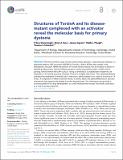Structures of TorsinA and its disease-mutant complexed with an activator reveal the molecular basis for primary dystonia
Author(s)
Demircioglu, Fatma Esra; Ingram, Jessica; Ploegh, Hidde; Schwartz, Thomas; Sosa, Brian A.
DownloadDemircioglu-2016-Structures of Torsin.pdf (1.947Mb)
PUBLISHER_CC
Publisher with Creative Commons License
Creative Commons Attribution
Terms of use
Metadata
Show full item recordAbstract
The most common cause of early onset primary dystonia, a neuromuscular disease, is a glutamate deletion (DE) at position 302/303 of TorsinA, a AAA+ ATPase that resides in the endoplasmic reticulum. While the function of TorsinA remains elusive, the DE mutation is known to diminish binding of two TorsinA ATPase activators: lamina-associated protein 1 (LAP1) and its paralog, luminal domain like LAP1 (LULL1). Using a nanobody as a crystallization chaperone, we obtained a 1.4 A˚ crystal structure of human TorsinA in complex with LULL1. This nanobody likewise stabilized the weakened TorsinADE-LULL1 interaction, which enabled us to solve its structure at 1.4 A˚ also. A comparison of these structures shows, in atomic detail, the subtle differences in activator
interactions that separate the healthy from the diseased state. This information may provide a structural platform for drug development, as a small molecule that rescues TorsinADE could serve as a cure for primary dystonia.
Date issued
2016-08Department
Massachusetts Institute of Technology. Department of Biology; Whitehead Institute for Biomedical ResearchJournal
eLife
Publisher
eLife Sciences Publications, Ltd.
Citation
Demircioglu, F Esra et al. “Structures of TorsinA and Its Disease-Mutant Complexed with an Activator Reveal the Molecular Basis for Primary Dystonia.” eLife 5 (2016): n. pag.
Version: Final published version
ISSN
2050-084X